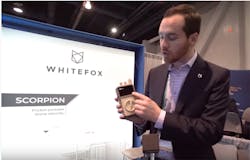Drone Identification and Mitigation Tech from CES 2020
Airport incidents, war theater and rogue drone reports are piling up worldwide and the demand for counter-drone (cUAS) systems continues. Anti-drone solutions are often categorized as one or a combination of detection, non-interactive or drone interdiction. At CES 2020, WhiteFox Defense may have signaled the beginning of new categories, in drone identification and mitigation.
With the FAA predicting that 7 million drones will be in U.S. airspace by 2020, we need a solution for what WhiteFox calls universal traffic management (UTM) – a set of services that create a completely digital and mostly autonomous trusted framework for drones to operate in. UTM aims to change the fact that millions of unregistered, anonymously flown and non-identifiable unmanned aircraft are flying in U.S. airspace.
“One of the problems with drones is that they are amazingly powerful; but, unless you know the drone is authorized, you really have no way to mitigate that drone,” WhiteFox CEO Luke Fox explained to me as part of a demo on the show floor.
This is where the FAA’s new Remote ID requirement comes into play. Introduced on Dec. 31, 2019, it would require all commercial-use drones and any drones more than 0.55 pounds to register with the FAA.
“The remote identification of unmanned aircraft systems in the airspace of the United States would address safety, national security, and law enforcement concerns regarding the further integration of these aircraft into the airspace of the United States while also enabling greater operational capabilities,” reads the proposal – which closes for comment in March.
WhiteFox has already come to market with a solution for Remote ID called WISDM. The product comes in two forms – either as a physical product that attaches to a drone, or as a protocol that is part of a drone’s software – and provides trust and authentication of drones. “WISDM technology (enables users to) pull up the Drone’s Remote ID on a smartphone or tablet,” Fox said. “WISDM is the fastest way to be completely compliant.”
The product supports multiple wireless communications, including Bluetooth, WiFi, Cellular and a long-range RF capability that provides about 20 miles.
“(Law enforcement) needs to be able to look into the sky, see a drone and say instantly that the drone is supposed to be there,” Fox said. “Right now, they have no means of doing that and often there is panic when someone sees a drone even though it is their own.”
Beyond identification, safe, selective, and surgical mitigation is needed to allow drone and counter-drone technology to co-exist. Both play vital roles in a healthy drone ecosystem and it is, in fact, possible for them to work together. Simply detecting, tracking and identifying the drones in airspace can, in and of itself, be an effective form of airspace security.
At CES, Fox also demonstrated both pocket portable and permanent drone detection and mitigation devices – the DroneFox and Scorpion 2.
The DroneFox solution fits in an 11U high rack and even has a version deployable in large temporary event venues. For counter-drone stakeholders with mitigation authority, there are a variety of methods available. The most scalable and effective method, however, would be able to select one unknown drone out of a swarm of known, or friendly drones, and instantly return it to its home location, safely land the drone in place, or send it to a pre-determined location.
“It covers the entire facility – (essentially) a firewall over the entire space,” Fox explained. “Good drones can come in and it can surgically remove bad drones from the airspace.”
The Scorpion 2 is a new hand-held device to detect known and unknown drones in the immediate airspace. Fox demoed the product live on video, at www.securityinfowatch.com/21120853.
Steve Surfaro is Chairman of the Public Safety Working Group for the Security Industry Association (SIA). Follow him on Twitter, @stevesurf.
About the Author

Steve Surfaro
Steve Surfaro
Steve Surfaro is Chairman of the Public Safety Working Group for the Security Industry Association (SIA) and has more than 30 years of security industry experience. He is a subject matter expert in smart cities and buildings, cybersecurity, forensic video, data science, command center design and first responder technologies. Follow him on Twitter, @stevesurf.
